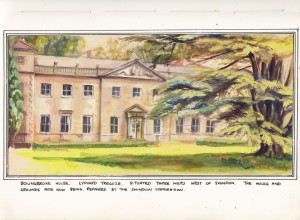Owthorpe, Nottinghamshire

Hidden Content, Images, Videos and Documents
Lucy St.John, sister of the 1st baronet, Sir John St.John, lived for some time with her daughter and son-in-law, Lucy Hutchinson and Colonel John Hutchinson at Owthorpe, and died there in 1658. She is buried in St. Margaret's church, which adjoins the site of the house.
The church is a quaint little edifice, containing monuments of the Hutchinsons; and in the field adjoining it may be clearly discerned the site which the old Hall occupied. Colonel Hutchinson took a great interest in his land, and the fish-ponds which he constructed are still visible, along with the avenue of trees still remaining which was planted in his lifetime. Although the house no longer stands, there are wonderful descriptions of the mansion and its parklands still accessible.
A little about the Hutchinsons, and detailed information about the house and land can be found on this excellent resource:
http://www.nottshistory.org.uk/books/mee1938/owthorpe.htm
A brief extract from Sir Arthur Mee's 1938 Edition of The King's England:
We can still picture it as it was when generations of Hutchinsons lived here, when Colonel John Hutchinson, the Puritan Governor of Nottingham who kept open the way from north to south for the Commonwealth, brought here his young wife Lucy, who was to enrich literature with her delightful Memoirs. The bride was loth to come to the place she grew to love, for the north, she wrote, "was a formidable name among the London ladies," and she was a Londoner indeed, born in the Tower itself, where her father, Sir Allen Apsley, was governor, and a good friend to his prisoner Raleigh. It was Lucy's mother who paid for Sir Walter Raleigh's chemical experiments.
Here Hutchinson and Lucy wandered in the happy days before the Civil War, guardians of the poor. Up at the big house, while he was studying divinity and the problems which were soon to rend the nation asunder, she, versed in classical languages as well as in Greek and Hebrew, was translating Lucretius into verse.
The scene changes. War has come; he has prayed to God for guidance; has decided that justice is on the side of Parliament; and has gone to fight for his faith. A little troop of horse comes here stealthily by night to carry Lucy and the children through the Royalist lines to the safety of Nottingham Castle, where she is to be the 17th century Florence Nightingale, nursing and healing wounded Puritans and Cavaliers with equal tenderness.
Again and again Cavaliers come raiding and ravaging, and the old house is made a ruin. But the Civil War ends, and Colonel Hutchinson and his wife return to rebuild and restore in blissful peace. She tells us that "the colonel lived with all imaginable retiredness at home, and, because his active spirit could not be idle nor sordidly employed, took up his time in opening springs and planting trees and dressing his plantations. These were his recreations, wherein he relieved many poor labourers when they wanted work, which was a very comfortable charity to them and to their families. With these he entertained himself, giving them much encouragement in their honest labours, so that they were delighted to be employed by him."
Here still are some of his trees growing; here is the church in which he sleeps. They brought him here from Sandown Castle, where he died, in a hearse drawn by six horses in mourning, with a mourning coach and six horses to wait on it, having crossed England and returned after redeeming the body from an unworthy castle governor who held it to ransom, and fighting with broken heads through hostile villages.
So he came home, in peace at last, to lie with his kindred, and with the inscription (the bold indictment of his accusers and judges) that "he died after harsh and strict imprisonment without crime or accusation." On his memorial (which gives his death as in 1663 instead of 1664) are the lines believed to be written by his widow, from which we take these:
This monument doth not commemorate
Vaine ayrie glorious titles, birth, and state ;
But sacred is to free, illustrious grace,
Conducting happily a mortal's race,
To end in triumph over death and hell,
When, like the prophet's cloake, the fraile flesh fell
Forsaken as a dull impediment,
Whilst love's swift fiery chariot climbed the ascent.
Nor are the reliques lost, but only torn,
To be made new, and in more lustre worn.
Full of this joy he mounted, he lay downe,
Threw off his ashes, and tooke up his crowne.
- Year:
- 1600-1700
- Creator:
- Elizabeth St.John
- Type:
- Building
- Location:
- Owthorpe, Nottinghamshire
- Copyright:
- Friends of Lydiard Park
- Credit:
- Andy Nicholson, http://www.nottshistory.org.uk
- Last updated on:
- Sunday 3rd April 2022


